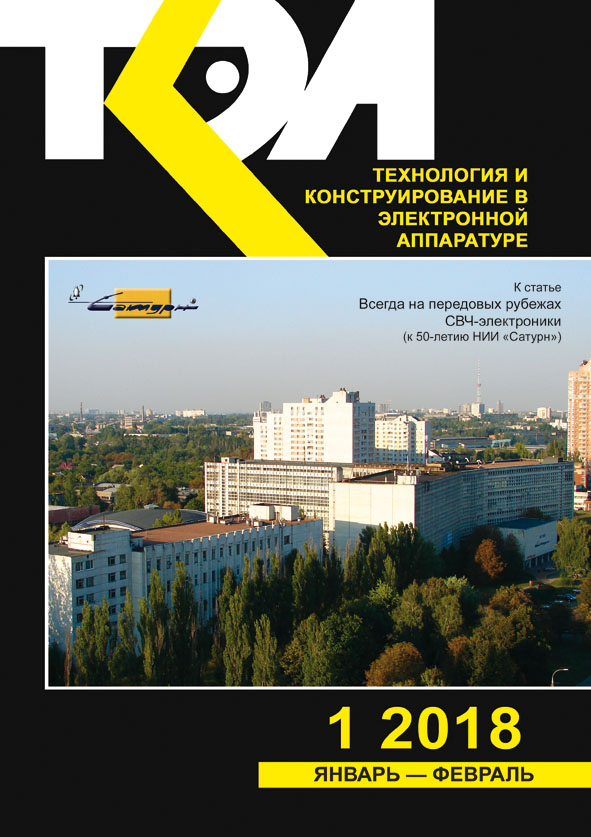Effect of sulfur on the scintillation properties of mixed ZnSxSe1–x crystals
Abstract
ZnSxSe1–x based luminescent materials are promising for use as X-ray and γ-ray detectors. The main advantage of ZnSxSe1–x crystals is the possibility of making of solid solutions over an entire X-range. It was found that varying the composition of ZnSxSe1–x crystals can change their luminescent properties. Many studies were focused on obtaining ZnSxSe1–x mixed crystals, most using a vapour phase growth methods, and only some of works used the directional solidification. The directional solidification techniques allow growing large ZnSxSe1–x crystals for high-energy particles detectors. Practical use, however, requires the knowledge about luminescent properties of ZnSxSe1–x bulk crystals.
This study reports the effect of sulfur content on basic properties of ZnSxSe1–xx bulk crystals grown by Bridgman- Stockbarger method. Six different compounds were studied: ZnS0.07Se0.93, ZnS0.15Se0.85, ZnS0.22Se0.78, ZnS0.28Se0.72, ZnS0.32Se0.68, ZnS0.39Se0.61. The ZnSe(Al) and ZnSe(Te) crystals grown at the similar conditions were used as reference. X-ray luminescence was studied using РЕИС-И (REIS-I) X-ray source (Cu, U = 10—45 kV). КСВУ-23 (KSVU-23) spectrophotometer was used to analyse the emission spectra. The afterglow level η (%) was determined by Smiths Heimann AMS-1 spectrophotometer at excitation by such X-ray and γ-ray sources as 123Cs and 241Am (59.5 keV).
Light output is one of the main characteristics of the scintillator, which determines its quality as a detector. The ZnSxSe1–x crystals demonstrated increase in the intensity of X-ray induced luminescence spectra with increasing of sulfur content and reached maximum for ZnS0.22Se0.78 composition. Light output of ZnSxSe1–x bulk crystals are higher than those of ZnSe(Te) and ZnSe(Al) commercial crystals. Moreover, thermal stability of scintillation light output of ZnSxSe1–x bulk crystals are also better than those. This investigation has revealed that basic properties of ZnSxSe1–x based scintillation detectors are better than those of ZnSe(Te) and ZnSe(Al).
References
Ryzhikov V., Galchinetski L., Galkin S., Danshin E., Kvitnitskaya V., Silin, V., Chernikov V. Combined detectors based on ZnSe(Te), CsI(Tl) and Si-PIN-PD for separate detection of alpha, beta and gamma radiation. IEEE Transactions on Nuclear Science, 2000, vol. 47, iss. 6, pp. 1979-1981. https://doi.org/10.1109/23.903832
Focsha A.I., Gashin P.A., Ryzhikov V.D., Starzhinskiy N.G. Preparation and properties of an integrated system «photosensitive heterostructure-semiconductor scintillator» on the basis of compound АIIBVI. International Journal of Inorganic Materials, 2001, vol. 21, iss. 8, pp. 1223-1225.https://doi.org/10.1016/S1466-6049(01)00134-9
Emam-Ismail M., El-Hagary M., Ramadan E., Matar A., El-Taher A. Influence of g-irradiation on optical parameters of electron beam evaporated ZnSe1–xTex nanocrystalline thin films. Radiation Effects and Defects in Solids, 2014, vol. 169, iss. 1, pp. 61-72. https://doi.org/10.1080/10420150.2013.811505
Gavrishchuk E. M. The polycrystalline zinc selenide for infrared optics. Inorganic Materials, 2003, vol. 39, iss. 9, pp. 1031-1049, https://doi.org/10.1023/A:1025529017192
Atroshenko L.V., Galchinetskii L.P., Galkin S.N., Silin V.I., Shevtsov N.I. Distribution of tellurium in melt-grown ZnSe(Te) crystals. Journal of Crystal Growth, 1999, vol. 197, iss. 3, pp. 471-474. https://doi.org/10.1016/S0022-0248(98)00963-4
Starzhinskiy N.G., Grinyov B.V., Galchinetskii L.P., Ryzhikov V.D. Stsintillyаtory na osnove soedinenii AIIBVI. Poluchenie, svoistva i osobennosti primeneniyа [The scintillators based compounds AIIBVI. Preparation, properties and features of the application]. Kharkov, Institute for Single Crystals, 2007, 296 p. (Rus)
Hussein R. H., Pagés O., Doyen-Schuler S., Dicko H., Postnikov A. V., Firszt F., Gorochov O. Percolation-type multi-phonon pattern of Zn(Se,S): Backward/forward Raman scattering and ab initio calculations. Journal of Alloys and Compounds, 2015, vol. 644, pp. 704-720. https://doi.org/10.1016/j.jallcom.2015.04.078
Fujita S., Mimoto H., Takebe H., Noguchi T. Growth of cubic ZnS, ZnSe and ZnSxSe1–x single crystals by iodine transport. Journal of Crystal Growth, 1979, vol. 47, iss. 3, pp. 326-334. https://doi.org/10.1016/0022-0248(79)90195-7
Hajj Hussein R., Pagès O., Firszt F., Marasek A., Paszkowicz W., Maillard A., Broch L. Near-forward Raman study of a phonon-polariton reinforcement regime in the Zn(Se,S) alloy. Journal of Applied Physics, 2014, vol. 116, no. 8, pp. 083511. https://doi.org/10.1063/1.4893322
Hussein R. H., Pagès O., Polian A., Postnikov A. V., Dicko H., Firszt F., Fertey P. Pressure-induced phonon freezing in the ZnSeS II–VI mixed crystal: phonon–polaritons and ab initio calculations. Journal of Physics: Condensed Matter, 2016, vol. 28, no. 20, pp. 205401. http://stacks.iop.org/0953-8984/28/i=20/a=205401
Trukhanova E. L., Levchenko V. I., Postnova L. I. Crystal growth of ZnSe1–xSx solid solutions at the lowest possible vapor pressure. Inorganic Materials, 2014, vol. 50, no. 1, pp. 10-12, https://doi.org/10.1134/S0020168514010191
Catano A., Kun Z. K. Growth and characterization of ZnSe and homogeneous ZnSxSe1–x crystals. Journal of Crystal Growth, 1976, vol. 33, iss. 2, pp. 324-330. https://doi.org/10.1016/0022-0248(76)90059-2
GOST 17038.2-79 Scintillation detectors of ionizing radiation. The method of measuring the light output of the detector at the peak of total absorption. (Rus)
Larach S., Shrader R.E., Stocker C.F. Anomalous variation of band gap with composition in zinc sulfo-and seleno-tellurides. Physics Review, 1957, vol. 108, iss. 3, pp. 587-593. https://doi.org/10.1103/PhysRev.108.587
Shirakawa Y., Kukimoto H. The electron trap associated with an anion vacancy in ZnSe and ZnSxSe1-x. Solid State Compounds, 1980, vol. 34, iss. 5, pp. 359—361. https://doi.org/10.1016/0038-1098(80)90575-X
Watkins G.D. Radiation Effects in Semiconductors. Gordon&Breach, New York, 1971, pp. 301—308.
Ryzhikov V. D., Starzhinskiy N. G., Galchinetskii L. P., Silin V. I., Tamulaitis G., Lisetskaya E. K. The role of oxygen in formation of radiative recombination centers in ZnSe1-xTex crystals. International Journal of Inorganic Materials, 2001, vol. 3, iss. 8, pp. 1227-1229. https://doi.org/10.1016/S1466-6049(01)00138-6
Berchenko N. N. et al. [Semiconductor solid solutions and their application: Reference tables]. Moskow, Military Publishing, 1982, 208 p. (Rus)
Gurvich A. M. [Introduction to the physical chemistry of crystal phosphorl]. Moskow, Graduate School, 1971, 336 p. (Rus)
Kilgus, Kotthaus R., Lange E. Prospect of CsI(Tl)-photodiode detectors for low-level spectroscopy. Nuclear Instruments and Methods in Physics Research Section A: Accelerators, Spectrometers, Detectors and Associated Equipment, 1990, vol. 297, iss. 3, pp. 425-440. https://doi.org/10.1016/0168-9002(90)91325-6
Pamplin B. R. Crystal growth. Kristall und Technik (Crystal Research and Technology). 1975, vol. 10, iss. 7, pp. 707-794. https://doi.org/10.1002/crat.19750100725
Copyright (c) 2018 Trubaieva O. G., Chaika M. A., Zelenskaya O. V., Lalayants A. I., Galkin S. N.

This work is licensed under a Creative Commons Attribution 4.0 International License.

